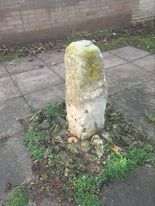Folklore: Cleves Cross and the Slaying of the Brawn
A short while ago, I cycled to the east of Ferryhill to find what is alleged to be the remains of "Cleves Cross", a monument steeped in local folklore. Ferryhill is a town to the east of Spennymoor, much of which was built during the County's mining heyday. The coal mines, such as Dean and Chapter colliery, provided employment for many Ferryhill townspeople (it was also the workplace of Spennymoor painter Norman Cornish). But in this post, I will be delving into the area's deeper past. To a time before the industrial revolution. The small stone Cleves Cross monument, sitting unassumingly near a bus stop on the east of the village allegedly marks the spot where Roger de Fery cunningly slayed the wild "Brawn" (boar) which had been terrorising local folk, including those in nearby Branspeth and Croxdale.
Below are pictures of Cleves Cross and the nearby information plaque:
The Brawn
It's difficult to imagine now, but wild boars were once numerous in the forests of England. The cultural significance of the animal is demonstrated by its appearance in the naming of natural features, such as Wild Boar Fell in the Yorkshire Dales. Legend has it that one such brawn menaced the inhabitants of Branspeth, a historic village in county Durham, whose castle was famously the starting point of the Rising of the North, the failed attempt by Catholic nobility in the north to overthrow the protestant Queen Elizabeth. According to some, the very name Brancepeth derives from the boar in question (Brawns-path). Others say it is more likely that the name is a derivation of "Brandon's Path", in reference to St Brandon, the name-sake of the church near the castle.
This brawn certainly got about. Legend has it that it roamed the woods stretching from Croxdale to Ferryhill, near Cleves Cross farm. The brawn had proved notoriously difficult to slay. That is, until it finally met its demise at the hands of Roger de Fery. Fery laid a trap for the brawn, digging a pit and covering it with superficial greenery. When the brawn fell into the pit, Fery slayed it with his sword. According to the local historian James J. Dodd, Fery may well be buried in Kirk Merrington churchyard, perhaps underneath the coffin shaped stone marked with a sword and spade on each side of a cross. This would make sense, given that these were the implements by which the brawn met its end.
In his history of Spennymoor, Dodds reproduces a poem recounting the story of the brawn. Here it is:
He feared not ye loute with hys staff,
Ne yet for ye knyghte in his mayle;
He cared ne more for ye monke with his boke,
Than ye fiendis in depe Croixdale,
Then out spake Hodge yt wyghte soe bolde,
Yt wous on on Fery hye;
And he hath sworne by Seynct Cudberte hys rode,
Yt thys horride brawne shall dye;
And he hath dygged a depe, depe pit,
And strewed it with braunches so grene.
Dodds suggests the fiends being referred to here allegedly inhabited the deep rivulet that runs by Croxdale Hall. The landscape round that area does have a gothic feel and the rivulet is surprisingly deep as it runs alongside the road at Sunderland Bridge Village.
When, you might be wondering, was the cross erected to commemorate Fery's slaying of the brawn? Frankly, no one knows. Legend has it that a cross was erected marking the spot where the brawn was buried. Is it the one that I visited on my bike? Perhaps, but if so, it hasn't stood in that place all that time. The Cleves Cross monument that stands today was dug up by the farmer at Cleves Cross Farm. The farmer believed it to be the one that originally commemorated the brawn's slaying. Then in 1867, following repairs to the stackyard, a deep hole was found, which many locals at the time believed to be the pit in which Fery stabbed the brawn. Honestly, I don't know if the cross I visited is the real thing, but it would be nice to think so. The worn plaque nearby the monument is less agnostic about its genuineness, it reads: "The large stone mounted on this site formed part of the Cleves Cross, where by tradition the brawn of Branspeth was killed by Roger de Fery, about the year of 1200 A.D."




Comments
Post a Comment